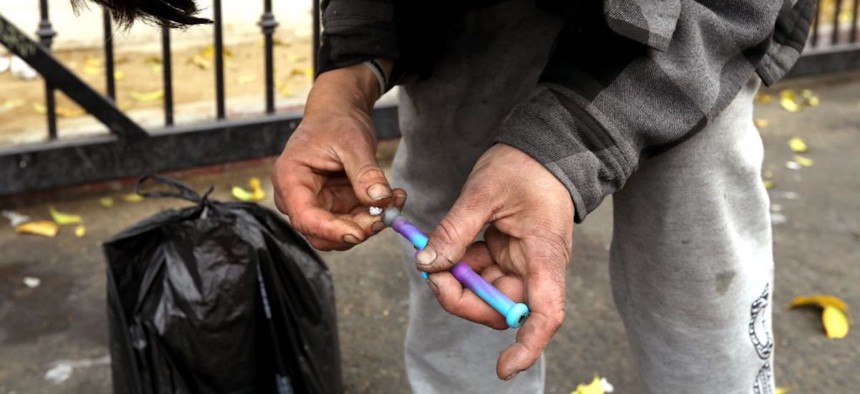State and local governments continue fight drug epidemic with tech

A person preps a pipe for a hit of fentanyl in Los Angeles on Dec. 12, 2024. Genaro Molina/Los Angeles Times via Getty Images
From at-home devices to federal lab testing, state and local officials are finding new ways to leverage tech to curb drug overdoses in their communities.
Data shows that the fentanyl crisis in the U.S. could be easing up, as every state in the nation continues to see the number of drug-related deaths decline in recent years. In California, overdose fatalities have decreased by 23% since a recorded peak in deaths in August 2023. But that isn’t stopping local officials from continuing their efforts to tackle the fentanyl epidemic.
In Los Angeles County — where 94% of opioid overdoses deaths involved fentanyl in 2023 — officials recently distributed 3,600 drug detection devices to nine sites across the jurisdiction, including community colleges and homeless shelters.
Users can test any small amount of powder, pill or crystal substance that the device screens for the presence of fentanyl, which county officials hope will reduce the risk and occurrences of fentanyl poisonings, according to a press release last month.
“Fentanyl deaths have destroyed families across LA County and fentanyl remains a leading cause of death among our unhoused population. But these deaths could be prevented by getting the right technology to people who need it,” said LA County Supervisor Janice Hahn in a statement to Route Fifty. “These devices can detect fentanyl in a substance and unlike other testing kits, they do not need sterilized water to work.”
The devices from medical diagnostics company Defense Diagnostics Inc. “work like a pregnancy test or a COVID test … and tend to be easier for a person to use and interpret,” said Kristin Omberg, senior technical advisor at the Pacific Northwest National Laboratory. At-home testing devices can also serve as an effective preventative care alternative for people who are reluctant to seek traditional health care for substance use disorders or an overdose.
“We learned during COVID that we get a lot better testing if we let people administer it themselves,” Omberg said. “There were a lot more people testing themselves once we went to home devices, so I think that giving somebody something that they can use in 20 minutes in their hand is a great thing, if you're using this as part of a harm reduction strategy.”
A drawback to personal tests is that government officials could lose direct visibility on substance use-related data if they have to rely on self-reported positive tests from users, which appears to be the case in LA County, she explained. Defense Diagnostics Inc. also offers users the opportunity to report a positive fentanyl test to their public-facing national heatmap to help inform communities, but doing so is voluntary.
Another risk to detection devices is that they typically do not screen for the concentration of fentanyl, just its presence, said Kristin Schneider, associate research professor at Johns Hopkins Bloomberg School of Public Health in an email to Route Fifty.
That’s where overdose prevention sites can offer state and local authorities a clearer picture of which substances and how much of them are circulating in their communities. Such sites are typically equipped with more advanced technology, like fourier transform infrared spectroscopy, which “can provide information about the presence of multiple substances that are present in a sample,” she said.
“FTIR analysis could tell you that a powder contains cocaine, fentanyl, and xylazine, while a test strip could only tell you that fentanyl was present,” Schneider explained. “Knowing the complete contents of a drug is critical so that people who use drugs have full information and can take appropriate steps to ensure their safety and prevent overdoses.”
The New York City’s Department of Health and Mental Health has supported FTIR-enabled drug testing at needle exchanges sites since 2021. The sites’ efforts have helped reverse an estimated 1,6000 overdoses since then.
Schneider pointed to the value of an emerging approach to substance use surveillance: main-in drug testing programs. Under the Maryland Department of Health’s Office of Harm Reduction’s Rapid Analysis of Drugs Program, for instance, people can bring their drug paraphernalia, such as needles, to syringe service programs across the state, where staff swab the materials and send the sample to the National Institute of Standards and Technology to be tested.
The mail-in approach “can help states and localities monitor their local drug supply,” Schneider said, highlighting how the state and federal program “was critical in identifying the emergence of xylazine in [Maryland] and is a model that could be readily implemented in other states.”






